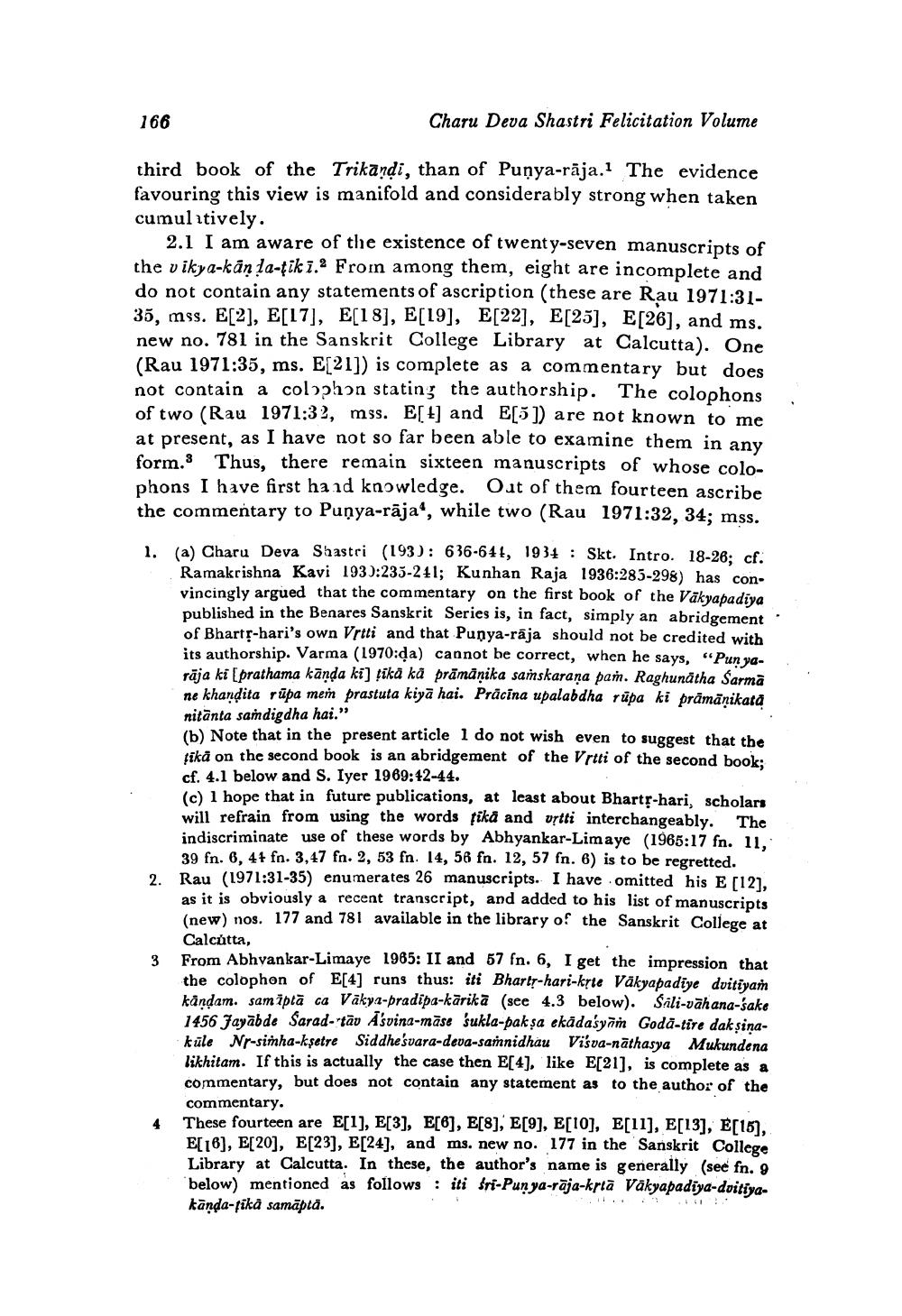Book Title: Authorship Of Vakya Kanda Tika Author(s): Ashok Aklujkar Publisher: Ashok Aklujkar View full book textPage 2
________________ 166 Charu Deva Shastri Felicitation Volume third book of the Trikāndi, than of Punya-rāja.1 The evidence favouring this view is manifold and considerably strong when taken cumulatively. 2.1 I am aware of the existence of twenty-seven manuscripts of the vikya-kan la-tik 7.2 From among them, eight are incomplete and do not contain any statements of ascription (these are Rau 1971:3135, mss. E[2], E[17], E[18], E[19], E[22], E[25], E [26], and ms. new no. 781 in the Sanskrit College Library at Calcutta). One (Rau 1971:35, ms. E[21]) is complete as a commentary but does not contain a colophon stating the authorship. The colophons of two (Rau 1971:32, mss. E[+] and E[5]) are not known to me at present. as I have not so far been able to examine them in any form.3 Thus, there remain sixteen manuscripts of whose colophons I have first hand knowledge. Out of them fourteen ascribe the commentary to Punya-rāja", while two (Rau 1971:32, 34; mss. 1. (a) Charu Deva Shastri (193): 636-641, 1934 : Skt. Intro. 18-26; cf. Ramakrishna Kavi 1930:235-241; Kunhan Raja 1936:285-298) has con. vincingly argued that the commentary on the first book of the Vākyapadiya published in the Benares Sanskrit Series is, in fact, simply an abridgement of Bhartr-hari's own Vrtti and that Punya-raja should not be credited with its authorship. Varma (1970:da) cannot be correct, when he says, "Pun ya. rāja ki (prathama kānda ki] jika kā prāmānika saņskarana pan. Raghunatha Sarmā ne khandita rūpa mer prastuta kiya hai. Präcina upalabdha rupa ki prāmānikata nitānta samdigdha hai." (b) Note that in the present article 1 do not wish even to suggest that the tikä on the second book is an abridgement of the Vrtti of the second book: cf. 4.1 below and S. Iyer 1969:42-44. (c) I hope that in future publications, at least about Bhartr-hari, scholars will refrain from using the words fikà and vrtti interchangeably. The indiscriminate use of these words by Abhyankar-Limaye (1965:17 fn. 11. 39 fn. 6, 4+ fn. 3,47 fn. 2, 53 fn. 14, 56 fn. 12, 57 fn. 6) is to be regretted. 2 Rau (1971:31-35) enumerates 26 manuscripts. I have omitted his EP121. as it is obviously a recent transcript, and added to his list of manuscripts (new) nos. 177 and 781 available in the library of the Sanskrit College at Calcutta, From Abhyankar-Limaye 1965: II and 57 fn. 6, I get the impression that the colophon of E[4] runs thus: iti Bharty-hari-kyte Väkyapadiye dvitiyan kandam. sam iptā ca Vākya-pradipa-kārikā (see 4.3 below). Sali-vāhana-sake 1456 fayābde Sarad-tāv Asvina-māse sukla-paksa ekādasyam Godā-tire dak sinakūle Nr-simha-ksetre Siddhesvara-deva-samnidhau Visva-nāthasya Mukundena likhitam. If this is actually the case then E[4], like E[21], is complete as a commentary, but does not contain any statement as to the author of the commentary. These fourteen are E[1], E[3], E[6], E[8], E[9], E[10], E[11], E[13], E[15], E[16], E[20], E[23], E[24], and ms. new no. 177 in the Sanskrit College Library at Calcutta. In these, the author's name is generally (see fn. 9 below) mentioned as follows: iti Sri-Pun ya-rāja-krtā Vakyapadiya-doitiyakanda-fika samāpta.Page Navigation
1 2 3 4 5 6 7 8 9 10 11 12 13 14 15 16 17 18 19 20 21 22 ... 24
